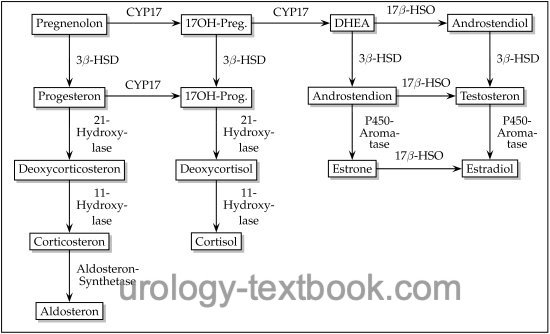You are here: Urology Textbook > Anatomy > Adrenal Glands
Adrenal Glands: Corticosteroids Regulation and Effects
- Anatomy of the Adrenal Glands: Gross appearance, vascular supply, innvervation.
- Anatomy of the Adrenal Glands: Corticosteroids.
- Anatomy of the Adrenal Glands: Catecholamines.
Biochemistry of steroid hormone production
All Corticosteroids are synthesized from a common precursor hormone (pregnenolone), produced from cholesterol by the P450SCC (cholesterol side chain cleavage). Corticosteroids include mineralocorticoids, glucocorticoids, and androgens [fig synthesis of corticosteroids].
 |
The adrenals produce dehydroepiandrosterone and androstenedione from 17-hydroxy-pregnenolone and 17-hydroxy progesterone. The genital organs convert the androgens into testosterone, dihydrotestosterone, estriol, and estradiol. Androgens from the adrenals become clinical significant in patients with enzyme defects of steroid synthesis (congenital adrenal hyperplasia) or metastatic prostate cancer.
Regulation of Glucocorticoids
Corticotropin-releasing hormone (CRH):
CRH is a hypothalamic hormone of 41 amino acids, which is transported via the bloodstream to the anterior pituitary, where it stimulates the release of ACTH (adrenocorticotropic hormone).
Adrenocorticotropic hormone (ACTH):
ACTH is a protein hormone produced by pro-opiomelanocortin (POMC) cleavage. The cleavage also forms β-lipotropin (β- LPH), β-melanocyte-stimulating hormone (β-MSH), β-endorphin and met-enkephalin.
ACTH leads to the release of cortisone; cortisone conversely prevents the release of ACTH (negative feedback). ACTH leads, to a lesser extent, also to the release of androgens. The following substances stimulate (in addition to CRH) the release of ACTH: vasopressin, oxytocin, adrenaline, angiotensin II, vasoactive intestinal peptide (VIP), serotonin, gastrin-releasing peptide, atrial natriuretic factor (ANF) and γ-aminobutyric acid (GABA).
Molecular mechanisms of cortisone action:
Glucocorticoids passively diffuse into the cell and bind to the nuclear steroid receptor proteins. The activated steroid receptors bind to specific DNA sequences (steroid response elements, SRE) and lead to increased gene expression.
Addition to the nuclear mechanism, glucocorticoids influence the ACTH and prostaglandin synthesis, prevent calcium influx into the cell, inhibit protein kinase C, and bind to membrane receptors.
Effects of Glucocorticoids
Metabolism and glucocorticoids:
Increased gluconeogenesis, lipolysis, blood sugar, and blood fats. Redistribution of fat storage.
Electrolytes and glucocorticoids:
Glucocorticoids possess mineralocorticoid effects: retention of sodium, loss of potassium, increase in extracellular fluid and blood pressure, and calcium excretion (vitamin D antagonist).
Musculoskeletal system and glucocorticoids:
Osteoblast inhibition, osteoporosis, Vit-D antagonist, hypocalcemia, catabolic, myopathy, and muscle atrophy.
Blood system and glucocorticoids:
Lymphocytopenia, increased neutrophils, polycythemia, thrombocytosis, and increased risk of thrombosis.
Immune system and glucocorticoids:
Lymphopenia and inhibition of chemotactic factors (IL1, IL2, macrophages, MIF) reduce the humoral and cellular immune response. Glucocorticoids also inhibit the early inflammatory response (edema, fibrin, capillary dilation, capillary permeability, leucocyte migration) and the late inflammatory response (capillary and fibroblast proliferation).
Skin and glucocorticoids:
Atrophy, fragile vessels, telangiectasia, stretch marks.
CNS and glucocorticoids:
Euphoric or dysphoric reactions are possible. Increased excitability. Steroid cataract.
Aldosterone
The most important stimulus for the secretion of aldosterone is the renin-angiotensin-aldosterone system (RAAS). Aldosterone is a steroid hormone from the adrenal cortex, which influences on the water- and salt balance (mineralocorticoid).
Molecular mode of action of aldosterone:
Aldosterone is lipophil, enters easily the target cell and binds to the nuclear steroid receptor proteins. The activated steroid receptors bind to specific DNA sequences (hormone response elements, HRE) and lead to an increased gene expression.
Aldosterone promotes sodium and water retention, raises the blood pressure and lowers the potassium concentration. The effects of aldosterone take place in several organs:
- Kidneys: increased expression of sodium-potassium pumps, increased luminal permability for Na+ .
- Sweat glands: stimulates Na+ and water reabsorption in exchange for K+
- Gastrointestinal tract: stimulates Na+ and water reabsorption in exchange for K+
| Adrenals Anatomy | Index | Catecholamines |
Index: 1–9 A B C D E F G H I J K L M N O P Q R S T U V W X Y Z
References
Benninghoff 1993 BENNINGHOFF, A.: Makroskopische Anatomie, Embryologie und Histologie des Menschen.15. Auflage.
München; Wien; Baltimore : Urban und Schwarzenberg, 1993
 Deutsche Version: Corticosteroide der Nebennieren.
Deutsche Version: Corticosteroide der Nebennieren.
Urology-Textbook.com – Choose the Ad-Free, Professional Resource
This website is designed for physicians and medical professionals. It presents diseases of the genital organs through detailed text and images. Some content may not be suitable for children or sensitive readers. Many illustrations are available exclusively to Steady members. Are you a physician and interested in supporting this project? Join Steady to unlock full access to all images and enjoy an ad-free experience. Try it free for 7 days—no obligation.
New release: The first edition of the Urology Textbook as an e-book—ideal for offline reading and quick reference. With over 1300 pages and hundreds of illustrations, it’s the perfect companion for residents and medical students. After your 7-day trial has ended, you will receive a download link for your exclusive e-book.